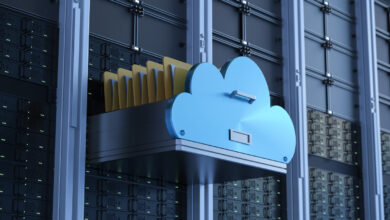4 Data Center Migration Best Practices

[ad_1]
Master data center migration, from strategic planning and asset inventory to continuous testing and post-migration optimization and understand its challenges, for a seamless transition.
-

Image: Sashkin/Adobe Stock
While the cloud remains a relatively small segment of corporate IT, its growth is staggering. This growth is driven by new applications designed for the cloud and businesses moving their existing systems there to become more agile and cost-effective. As more companies look to make this move, guidance from big cloud providers like AWS, Microsoft Azure and Google Cloud is becoming crucial.
However, moving from traditional systems to the cloud can be tricky. One rule of thumb for timing a data center migration is to move once your hardware is at least three years old, which tends to be when enterprises consider replacing it. However, it’s not just about the technical side; it involves careful budgeting and planning.
More importantly, it requires strong support from company leaders. The best time to move to the cloud isn’t just about how old your current systems are; it’s about when your company’s leaders are fully committed to this change. This move is more than a simple upgrade — it’s a step toward transforming how your business operates, and it needs enthusiastic backing from the top.
Jump to:
Steps to a successful data center migration
Data migration is a key part of any data center transition. A well-executed migration not only ensures data integrity but also sets the stage for the organization’s future growth and innovation. Here are four steps to navigate this complex process successfully.
1. Establish a phased plan and business case
IT teams, in collaboration with executive leadership, should begin by developing a clear plan. They need to assess the business impact, considering factors like time to market and potential revenue. IT teams should then determine the appropriate migration strategy for the applications, whether rehosting, replatforming or refactoring depending on their centrality to customer experience.
SEE: Check out these common approaches to data migration.
A phased approach allows for manageable segments, reducing risk and enabling incremental improvements. Each phase should have clear objectives, deliverables and metrics to measure success.
2. Inventory current assets and map to provider infrastructure
IT departments should catalog their applications and their requirements. Understand the services your chosen cloud provider offers and map out the migration path for each asset. This includes mapping your servers to the cloud’s machine types or different database services. For instance, a decision might be made to move from a self-managed instance of MySQL to a fully managed database service to support the application.
PREMIUM: Use this checklist for building and decommissioning data centers.
This step is crucial for helping these IT teams identify their dependencies and ensure that their applications will function correctly in the new environment. A thorough inventory conducted by IT also helps in cost estimation and resource allocation, preventing surprises during the migration.
3. Institute checkpoints and continuous testing
Project managers should set periodic checkpoints to measure progress and ensure that continuous testing is conducted to optimize performance and address any issues promptly. Regular testing, a responsibility of the IT team, ensures that the migration process aligns with objectives and provides an opportunity to course-correct if necessary. It also helps in validating the performance and functionality of applications in the new environment.
4. Post-migration assessment and optimization
After migration, IT teams should focus on continuous optimization. This could involve increasing automation, enhancing observability tools and fine-tuning operations to leverage the full potential of the new data center or cloud infrastructure. Regular assessments, conducted post-migration, are vital to ensure that the migrated systems deliver the expected benefits and performance. Optimization efforts may include cost management, performance tuning and security enhancements.
Common challenges in migrating a data center
The data center migration process is filled with potential pitfalls. Recognizing and preparing for these common data migration mistakes and challenges will make the transition significantly smoother.
Talent shortage
A significant hurdle in data center migration is the scarcity of skilled professionals. The complexity of migration demands expertise that’s often in short supply, making it imperative to invest in training or seek external assistance.
SEE: Australia is facing a severe shortage of IT talent.
Organizations often underestimate the need for specialized skills, leading to delays and increased costs. It’s essential to have a team with the right mix of skills, including cloud architecture, security and project management, to navigate the complexities of migration successfully.
Lack of clear planning
A well-structured plan is crucial. Ambiguities in strategy can lead to oversights and missteps. Ensure the plan is comprehensive, with clear objectives, timelines and responsibilities.
Inadequate planning can result in data loss, downtime and a failure to realize the full benefits of migration. Have a detailed roadmap that outlines each step of the migration process, including data backup, testing and validation procedures.
Data integrity and loss
Data can become corrupted, or worse, lost if not handled properly. With thorough data backup and verification protocols, organizations can prevent detrimental data-related disasters. Regularly check data integrity and have a well-formulated recovery plan in place to mitigate risks associated with data corruption or loss.
Unforeseen costs and delays
Migrations often run over budget and schedule due to unforeseen technical issues or scope changes. Rigorous pre-migration testing and contingency planning can help mitigate these risks and keep the project on track. It’s important to have a buffer in both budget and timeline to accommodate unexpected challenges that may arise during the migration.
Resistance to change
Organizational resistance to change can impede migration efforts. Involve all stakeholders early in the process, clearly communicate the benefits and address any concerns to ensure a smooth transition. Change management strategies, including training and support, can help ease the transition and foster a positive attitude towards the new environment.
For all of the moving parts involved in data center migration, leveraging the right tools is not up for negotiation. Data migration tools will simplify data transfer, ensure integrity and streamline the entire process. But prior to selecting tools, it’s of benefit to understand the types of data migration to understand the best approaches and strategies.
[ad_2]
Source Credit



